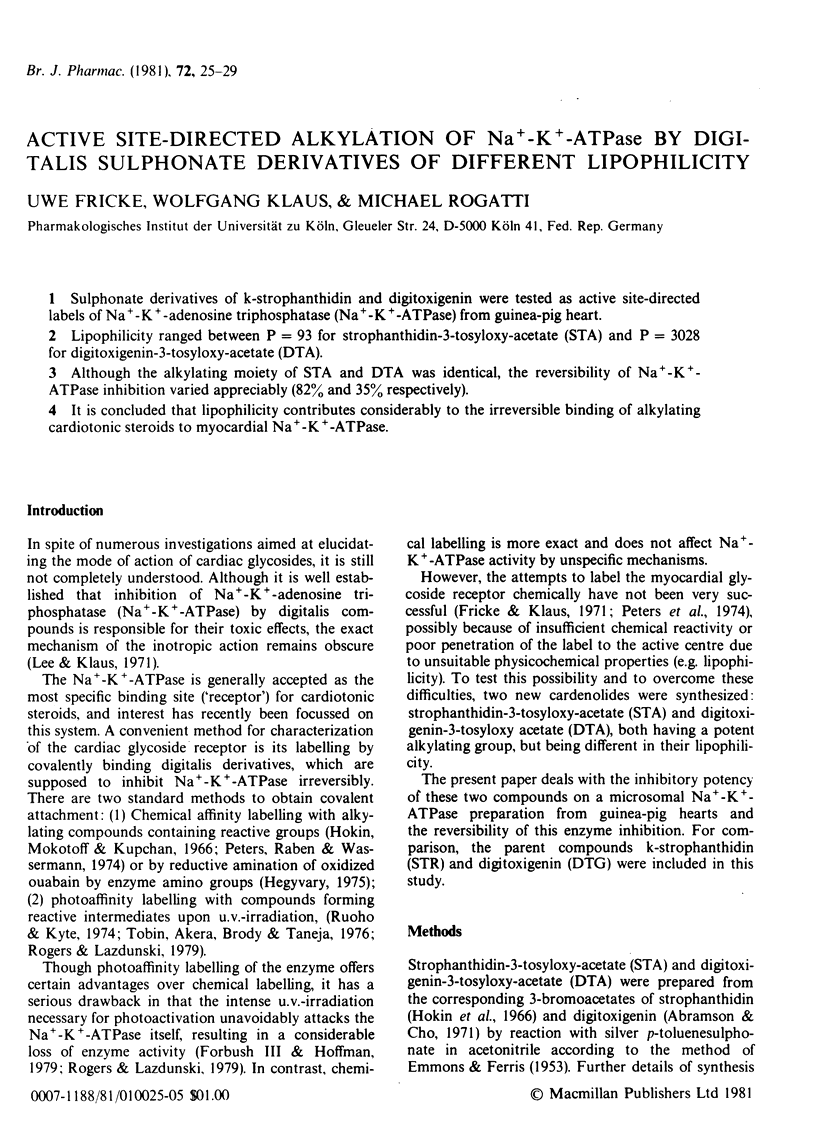Abstract
1 Sulphonate derivatives of k-strophanthidin and digitoxigenin were tested as active site-directed labels of Na+-K+-adenosine triphosphatase (Na+-ATPase) from guinea-pig heart. 2 Lipophilicity ranged between P = 93 for strophanthidin-3-tosyloxy-acetate (STA) and P = 3028 for digitoxigenin-3-tosyloxy-acetate (DTA). 3 Although the alkylating moiety of STA and DTA was identical, the reversibility of Na+-K+-ATPase inhibition varied appreciably (82% and 35% respectively). 4 It is concluded that lipophilicity contributes considerably to the irreversible binding of alkylating cardiotonic steroids to myocardial Na+-K+-ATPase.
Full text
PDF




Selected References
These references are in PubMed. This may not be the complete list of references from this article.
- Abramson H. N., Cho J. S. Inhibition of sodium- and potassium-dependent adenosine triphosphatase by cardenolide alkylating agents. J Med Chem. 1971 Jun;14(6):509–511. doi: 10.1021/jm00288a011. [DOI] [PubMed] [Google Scholar]
- Akera T., Brody T. M. Membrane adenosine triphosphatase. The effect of potassium on the formation and dissociation of the ouabain-enzyme complex. J Pharmacol Exp Ther. 1971 Mar;176(3):545–557. [PubMed] [Google Scholar]
- Akera T., Ku D., Tobin T., Brody T. M. The complexes of ouabain with sodium- and potassium-activated adenosine triphosphatase formed with various ligands: relationship to the complex formed in the beating heart. Mol Pharmacol. 1976 Jan;12(1):101–114. [PubMed] [Google Scholar]
- Eibl H., Lands W. E. A new, sensitive determination of phosphate. Anal Biochem. 1969 Jul;30(1):51–57. doi: 10.1016/0003-2697(69)90372-8. [DOI] [PubMed] [Google Scholar]
- Forbush B., 3rd, Hoffman J. F. Direct photoaffinity labeling of the primary region of the ouabain binding site of (Na+ + K+)-ATPase with [3H]ouabain, [3H]digitoxin and [3H]digitoxigenin. Biochim Biophys Acta. 1979 Aug 7;555(2):299–306. doi: 10.1016/0005-2736(79)90169-x. [DOI] [PubMed] [Google Scholar]
- Fricke U., Klaus W. A simple preparation technique for a microsomal Maplus-K-plus-activated ATPase from cardiac tissues of different species. Prep Biochem. 1974;4(1):13–29. doi: 10.1080/00327487408068183. [DOI] [PubMed] [Google Scholar]
- Fricke U., Klaus W. Die Haftung verschiedener Cardenolide am Papillarmuskel und einer mikrosomalen ATPase des Meerschweinchenherzens. Naunyn Schmiedebergs Arch Pharmakol. 1971;268(2):200–209. [PubMed] [Google Scholar]
- Hegyvary C. Covalent labeling of the digitalis-binding component of plasma membranes. Mol Pharmacol. 1975 Sep;11(5):588–594. [PubMed] [Google Scholar]
- Hokin L. E., Mokotoff M., Kupchan S. M. Alkylation of a brain transport adenosinetriphosphatase at the cardiotonic steroid site by strophanthidin-3-haloacetates. Proc Natl Acad Sci U S A. 1966 Apr;55(4):797–804. doi: 10.1073/pnas.55.4.797. [DOI] [PMC free article] [PubMed] [Google Scholar]
- Okita G. T., Richardson F., Roth-Schechter B. F. Dissociation of the positive inotropic action of digitalis from inhibition of sodium- and potassium-activated adenosine triphosphate. J Pharmacol Exp Ther. 1973 Apr;185(1):1–11. [PubMed] [Google Scholar]
- Peters T., Raben R. H., Wassermann O. Evidence for a dissociation between positive inotropic effect and inhibition of the Na+-K+-ATPase by ouabain, cassaine and their alkylating derivatives. Eur J Pharmacol. 1974 May;26(2):166–174. doi: 10.1016/0014-2999(74)90223-4. [DOI] [PubMed] [Google Scholar]
- Rogers T. B., Lazdunski M. Photoaffinity labeling of the digitalis receptor in the (sodium + potassium)-activated adenosinetriphosphatase. Biochemistry. 1979 Jan 9;18(1):135–140. doi: 10.1021/bi00568a021. [DOI] [PubMed] [Google Scholar]
- Ruoho A. E., Hokin L. E., Hemingway R. J., Kupchan S. M. Hellebrigenin 3-haloacetates: potent site-directed alkylators of transport adenosinetriphosphatase. Science. 1968 Mar 22;159(3821):1354–1355. doi: 10.1126/science.159.3821.1354. [DOI] [PubMed] [Google Scholar]
- Ruoho A., Kyte J. Photoaffinity labeling of the ouabain-binding site on (Na+ plus K+) adenosinetriphosphatase. Proc Natl Acad Sci U S A. 1974 Jun;71(6):2352–2356. doi: 10.1073/pnas.71.6.2352. [DOI] [PMC free article] [PubMed] [Google Scholar]
- Tobin T., Akera T., Brody T. M., Taneja H. R. Cardiotonic site directed irreversible inhibition of Na+ + K+-ATPase by 3-azidoacetylstrophanthidin, a photochemical analogue of strophanthidin. Eur J Pharmacol. 1976 Jan;35(1):69–76. doi: 10.1016/0014-2999(76)90301-0. [DOI] [PubMed] [Google Scholar]
- Tobin T., Sen A. K. Stability and ligand sensitivity of (3H)ouabain binding to (Na+ + K+)ATPase. Biochim Biophys Acta. 1970 Jan 14;198(1):120–131. doi: 10.1016/0005-2744(70)90040-9. [DOI] [PubMed] [Google Scholar]
- Yoda A., Hokin L. E. On the reversibility of binding of cardiotonic steroids to a partially purified (Na+K)-activated adenosinetriphosphatase from beef brain. Biochem Biophys Res Commun. 1970 Aug 24;40(4):880–886. doi: 10.1016/0006-291x(70)90985-x. [DOI] [PubMed] [Google Scholar]
- Yoda A. Structue-activity relationships of cardiotonic steroids for the inhibition of sodium- and potassium-dependent adenosine triphosphatase. I. Dissociation rate constants of various enzyme-cardiac glycoside complexes formed in the presence of magnesium and phosphate. Mol Pharmacol. 1973 Jan;9(1):51–60. [PubMed] [Google Scholar]
- Yoda A., Yoda S. Association and dissociation rate constants of the complexes between various cardiac aglycones and sodium- and potassium-dependent adenosine triphosphatase formed in the presence of magnesium and phosphate. Mol Pharmacol. 1977 Mar;13(2):352–361. [PubMed] [Google Scholar]


